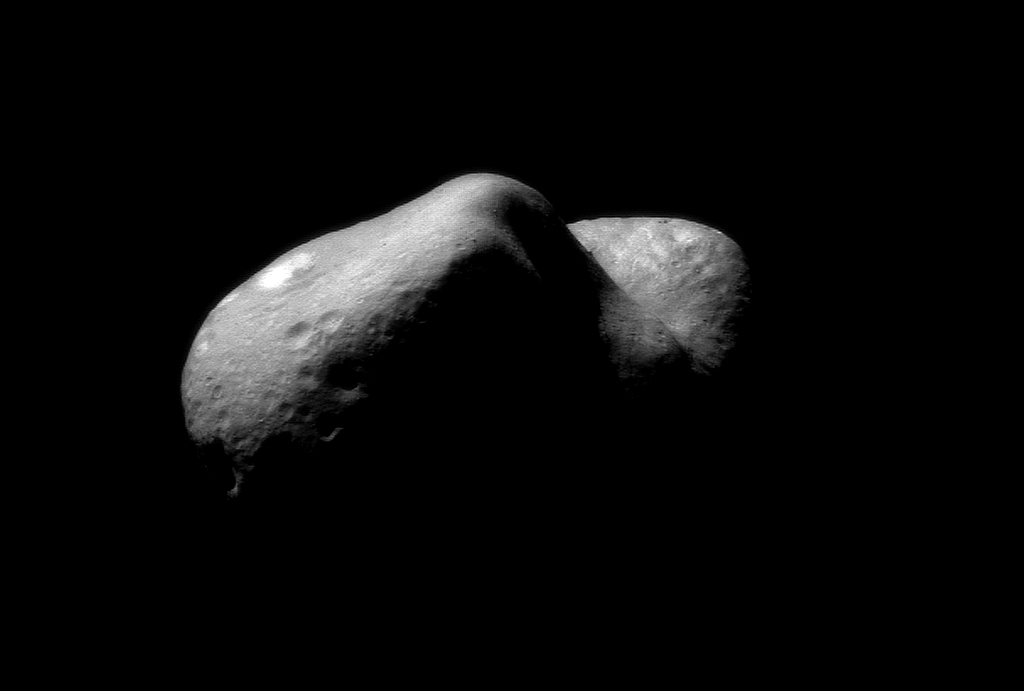A carbon asteroid traveler has been discovered at the outer edges of the solar system.

A lone asteroid on the edge of the solar system might look something like this.
Asteroids are the most interesting objects to study, because they give a lot of information about the origin of the solar system. In this case, the asteroids are very different. The bulk of such objects is concentrated in the asteroid belt, but a smaller part of them is scattered throughout the system. Recently, one such hermit object was discovered on the outer borders of the solar system.
According to astronomers, it was formed, most likely, in the main asteroid belt , which is located between the gas giant Jupiter and Mars neighbor Earth. But later for some reason he was thrown very far from the place of appearance. The distance from the asteroid belt to the current location of the object is several billion kilometers.
Discovered "traveler" refers to class C asteroids - the most common class with high carbon content. It includes three quarters of all known asteroids. Most carbon asteroids are in the outer part of the belt, 2.7 AU behind the orbit. In fact, their number may be even greater, but it is not so easy to detect carbon asteroids due to the low reflectivity of their surface.
')
They are very dark, the albedo of the carbon asteroid is 0.03-0.1. So the discovery of such an object on, in fact, the backyard of the solar system - good luck. Scientists are really lucky. And lucky because the asteroid, which is billions of kilometers away from its brethren, is an indirect confirmation of the migration hypothesis . According to it, during the formation of the solar system, the gas-giant giants of the planet were relatively formed on it, then coming closer to the Sun, then moving away from it. Jupiter, moving from orbit to orbit, led Saturn, who was distant from the Sun, behind him.
It is believed that during the migration of the giant planet fulfilled the role of a giant vacuum cleaner, removing excess dust and small objects. It is possible that all this was the cause and appearance of the materials from which Mercury, Venus, Earth, Mars were formed.
The asteroid in question received a sequence number (120216) 2004 EW95. He was discovered by a research team from Queen’s University in Belfast, UK. The group is led by astronomer Tom Sekkal. Having calculated the trajectory of the asteroid, the scientists came to the conclusion that the asteroid had long been located in the inner chambers of the solar system, but for some reason was thrown out of its limits.
And as astronomers believe, the reason is precisely the very migration that was discussed above. The carbon asteroid (120216) 2004 EW95 was discovered by Hubble, and astronomers noticed it in 2004. It differed from other objects in the Kuiper belt — first of all, the spectrum was different. After it became clear that the asteroid is very unusual, they began to observe it with the help of the VLT (Very Large Telescope) complex. Spectral analysis showed that the asteroid contains iron oxides and phyllosilicates .

However, the most unusual of all asteroids ever discovered was not (120216) 2004 EW95, but an object from another star system. He was named U1 (Oumuamua) . The object has an unusual shape - it is a highly elongated ellipsoid with a ratio of length to thickness of 10: 1. The period of its rotation is about 7 hours. Oumuamua is so strange that it even initially suggested that it could be a spaceship from another system.
But no, the object still has a natural origin - it is an elongated piece of ice, which is covered with "glaze" of organic matter. Its layer is a reliable protection for water ice, which almost does not evaporate under the action of the rays of the sun. This view was confirmed by astronomers from a number of ground-based observatories located around the world. A group of scientists led by Alan Fitzsimmons clarified the composition of the surface layer of the object. As it turned out, "glaze" contains a large amount of Tolin, which are formed when the cosmic impact of the best on ice, containing the simplest organic compounds.
The surface layer of the object is 30-40 meters thick. There is almost no water ice here, but a high concentration of organic matter. The ice is located inside the asteroid, and it is quite strong, which allows the object not to collapse under the influence of forces generated during the rotation of the asteroid around its axis.
Source: https://habr.com/ru/post/374487/
All Articles